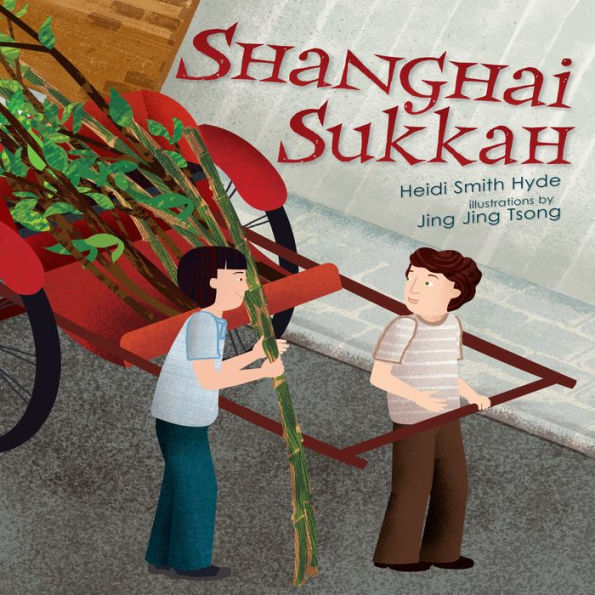Publishers Weekly
08/03/2015
As she did in Elan, Son of Two Peoples (2014), Hyde explores how Jewish traditions thrived in another cultural context, in this case the struggles and successes of European Jews who immigrated to China ahead of WWII. Although "Shanghai was nothing like Berlin," a boy named Marcus slowly adjusts to his new home, finding support in fellow young immigrants and a new Chinese friend, Liang. Liang points out that the approaching Moon Festival celebrates the harvest like the Jewish holiday of Sukkot, and lanterns from the festival eventually decorate the rooftop sukkah that Marcus and his friends build from bamboo. Rendered in an urban palette of pale grays and browns, Tsong's (A Bucket of Blessings) crisp digital collages come alive during the Moon Festival as a dragon races down the street during a parade and orange lanterns cast a warm glow on the night streets. Themes of friendship and perseverance come through strongly, and an afterword offers intriguing background information about (and archival photos of) the Jewish immigration to China. "During a time when most countries looked the other way," writes Hyde," China offered a haven." Ages 5–9. (Aug.)
From the Publisher
"In Shanghai's Hongkew district, two boys, one German-Jewish, one Chinese, share in the celebration of their two harvest holidays, Sukkot and the Moon Festival. Having fled Berlin with his family in advance of the Holocaust, 10-year-old Marcus is trying to make the best of their exile in the crowded Jewish neighborhood that's nestled in the bustling Chinese city. While most of his fellow yeshiva students keep to themselves, Marcus makes a new friend, Liang, bonding despite language and cultural differences. When autumn holidays approach, Marcus explains the tradition of building a sukkah, or traditional ceremonial hut, and happily accepts Liang's offer of help in its construction, though he's disappointed that the family's poverty means they can't use fruits and vegetables to decorate it. Seeing his friend's sadness, Liang invites Marcus to experience the Moon Festival, with its colorful red lanterns, moon-shaped cookies, and games. Liang's idea to decorate the sukkah with bright lanterns provides a welcome bridge between the two cultures. Tsong uses lithographs to create a layered, textured look, employing dark, drab hues to depict the poverty-stricken tenement district and vivid greens and red-orange tones for the sukkah and its lanterns. Hyde's straightforward text assumes basic understanding of the Holocaust, focusing on Marcus' experiences in Shanghai. While both holidays are but lightly sketched, themes of friendship and respect across cultures are compelling." — Kirkus Reviews
School Library Journal
11/01/2015
K-Gr 2—Marcus tries to make the best of his new home after his family flees Berlin for Shanghai to escape the Nazis. There, he makes friends with other Jewish boys and a Chinese boy named Liang. As the Sukkot holiday nears, Marcus wonders where and how his family can build their sukkah. With the help of his friends, they build one out of bamboo on the roof of their building. Due to food shortages, they cannot decorate the hut with the traditional fruits and vegetables. Liang tells Marcus about the upcoming Moon Festival, which is happening the next day. The boys celebrate both holidays together, and Liang adds red Chinese lanterns to the sukkah to help illustrate the warmth of friendship. A spread at the end gives some basic information about Jewish refugee life in Shanghai, including photographs. Tsong mixes printmaking and digital art for large, bright illustrations. The endpapers, which feature a street scene depicting Jewish and Chinese life, are especially lovely. The reasons why Marcus's family need to leave Europe are glossed over, keeping this holiday story light. VERDICT This heartwarming tale examines a little-known vibrant Jewish community while focusing on the joys and discovery of friendship.—Jennifer Rothschild, Arlington County Public Libraries, VA
Kirkus Reviews
2015-04-15
In Shanghai's Hongkew district, two boys, one German-Jewish, one Chinese, share in the celebration of their two harvest holidays, Sukkot and the Moon Festival. Having fled Berlin with his family in advance of the Holocaust, 10-year-old Marcus is trying to make the best of their exile in the crowded Jewish neighborhood that's nestled in the bustling Chinese city. While most of his fellow yeshiva students keep to themselves, Marcus makes a new friend, Liang, bonding despite language and cultural differences. When autumn holidays approach, Marcus explains the tradition of building a sukkah, or traditional ceremonial hut, and happily accepts Liang's offer of help in its construction, though he's disappointed that the family's poverty means they can't use fruits and vegetables to decorate it. Seeing his friend's sadness, Liang invites Marcus to experience the Moon Festival, with its colorful red lanterns, moon-shaped cookies, and games. Liang's idea to decorate the sukkah with bright lanterns provides a welcome bridge between the two cultures. Tsong uses lithographs to create a layered, textured look, employing dark, drab hues to depict the poverty-stricken tenement district and vivid greens and red-orange tones for the sukkah and its lanterns. Hyde's straightforward text assumes basic understanding of the Holocaust, focusing on Marcus' experiences in Shanghai. While both holidays are but lightly sketched, themes of friendship and respect across cultures are compelling. (historical note) (Picture book. 5-8)





